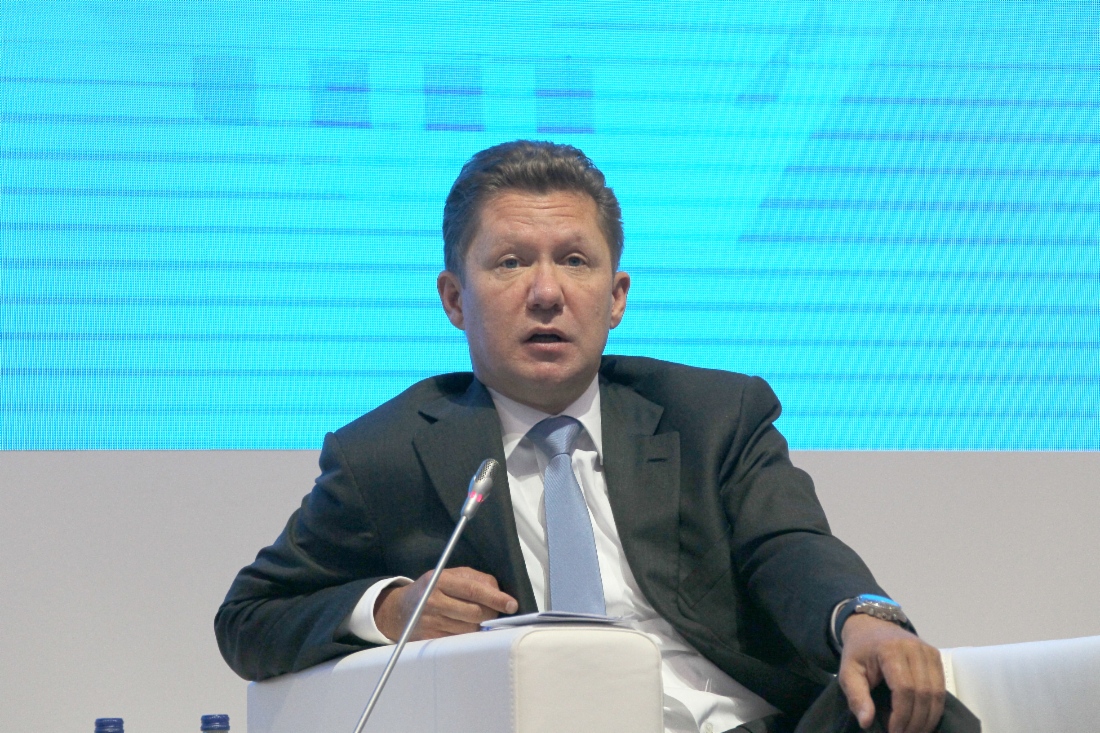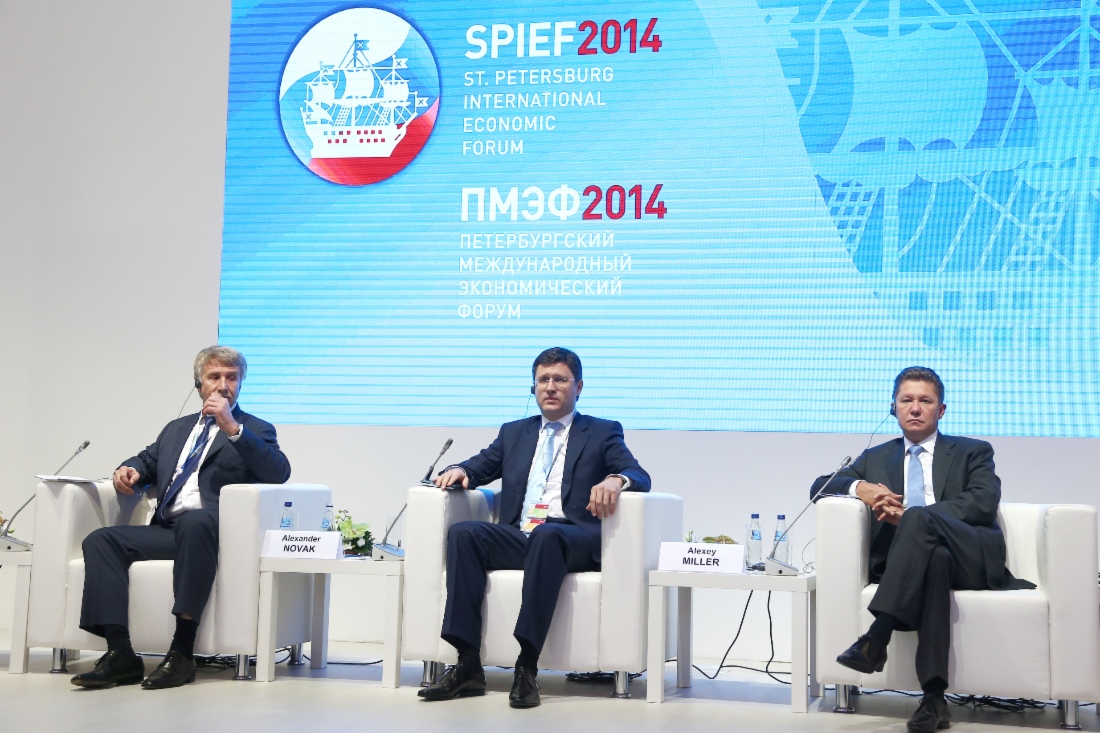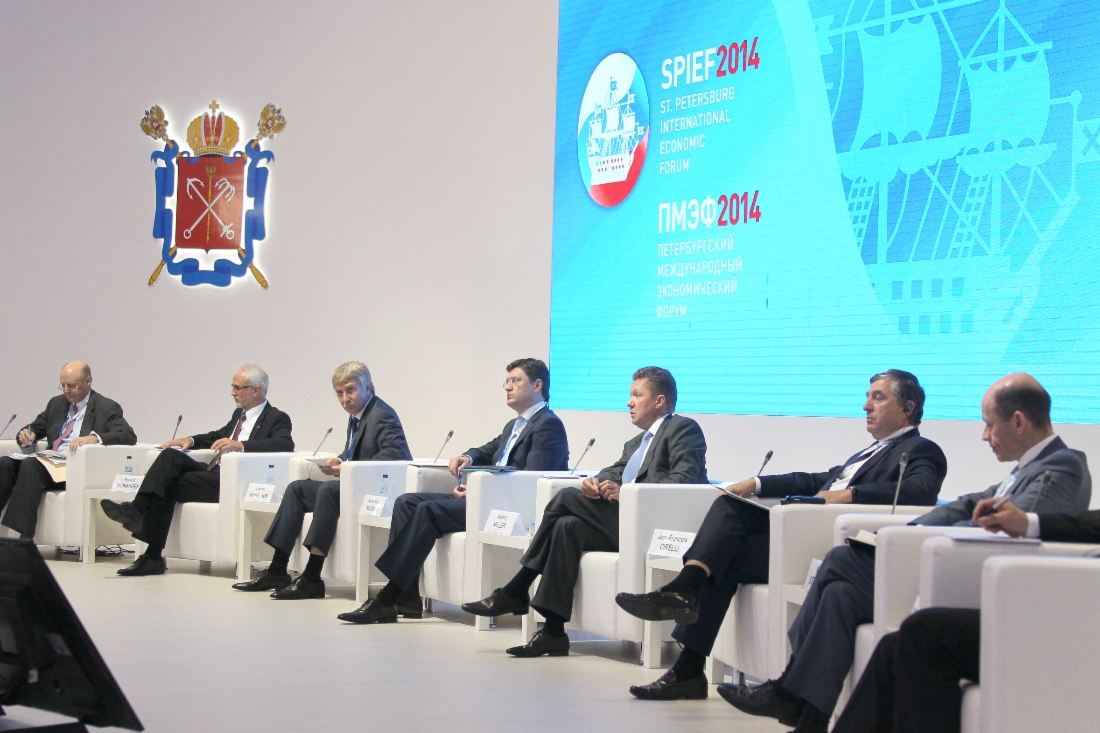Speech by Alexey Miller at St. Petersburg International Economic Forum – 2014
Speech by Alexey Miller at Changing Global Gas Market Geography plenary meeting, St. Petersburg International Economic Forum, May 23, 2014
There is a certain contradiction in the title of our discussion, which reads Changing Global Gas Market Geography, as there is no such thing as a global market. There can be only one global market, but there are currently three megamarkets and several major markets. By three megamarkets I mean, of course, the European market, the North American market and the Asia-Pacific market.
But the absence of a global market doesn’t mean there are no global companies. There are global companies – those that operate at several megamarkets and at major markets. And I am very pleased to see the executives of this category of companies here in the audience – GDF SUEZ and Shell, for example. And of course, Gazprom is also a global company – we operate in 51 countries worldwide.
You know, as recently as ten years ago some experts and analysts would say that in a moment, in just a little time liquefied natural gas would make the gas market global. But it didn’t happen.
You know, as recently as ten years ago some experts and analysts would say that in a moment, in just a little time liquefied natural gas would make the gas market global. But it didn’t happen. And the most interesting thing is that lately – and for quite a long while – the share of LNG in the global gas mix hasn’t changed at all. The ratio of LNG to pipeline gas has been at the level of 30 per cent for a long time. And I suppose, we won’t be mistaken if we agree that this proportion will remain unchanged in the mid-term.
Why is there no global market, why are there several megamarkets and some major markets? Firstly, it is because these markets have different resource bases and different economic conditions. It should be mentioned in this context that during the last decade the price trends have started varying among these markets – three markets, three different price trends – and the growing spread among these markets. Before 2008 the spread among the megamarkets was about USD 100, whereas now, after the crisis, it is USD 500 already.
I may suppose that this trend we observe today – and we observe it in the growing dominance of the Asia-Pacific market – will carry on. It is the Asia-Pacific market, which is not only the largest market, the dominating market, the developing market, but it is also the Asia-Pacific market that influences the European market, the North American market and major regional markets.
There are certain consequences of introducing the concept of spot trading into European market, the negative ones – and they are obvious.
European market and European Union (EU) gas market
This market has been affected by the concept of spot trading. And the priority is given to a short-term profit, to margins from trading operations at the expense of long-term contracts, to the prejudice of uninterrupted and reliable supply, which are secured by linking long-term contracts to a reliable resource base. And this concept of spot trading bears grave risks to the European gas market. There are certain consequences of introducing the concept of spot trading into the European market, the negative ones – and they are obvious.
First of all, it should be pointed out that the general EU policy for restraining gas supplies, the policy aimed at rising energy production from renewables caused certain deep structural changes in the European gas and energy markets.
However, the volume of gas required by Europe remains at the same level of 300 to 320 billion cubic meters a year. And the determining factor here is, on the one hand, the decline in domestic gas production in the EU countries, such as the Netherlands, Germany, the UK, such a traditional gas supplier as Norway. It’s the first thing. Secondly, it is a slump in gas supply from North Africa, Algeria, Egypt, Qatar and the Middle East.
The figures illustrating the current state of the European LNG market are simply terrifying: the load of LNG regasification terminals, with the total capacity exceeding 100 million tons, is merely 22 per cent.
In fact, as a Russian proverb runs, ‘they shot themselves in the foot’ – the spot trading philosophy, the European spot trading strategy made the European market lose in the global LNG competition. The figures illustrating the current state of the European LNG market are simply terrifying: the load of LNG regasification terminals, with the total capacity exceeding 100 million tons, is merely 22 per cent. I would like to draw your attention to the fact that in 2003 the European LNG regasification terminals were loaded to 90 per cent, whereas in 2013 Europe purchased less LNG than in 2003.
The question is, how did this happen? Another one is, what factors underlie such a trend? One of the factors is actually very simple: establishing spot hubs where the Middle Eastern LNG supposed to be sold.
That is to say, Europe has lost, literally lost the competition for liquefied natural gas.
But what do we see? We see a completely different picture. The well-known events in Japan, the well-known trends in Asia, a considerable price differences between the European and Asian markets made the Middle Eastern liquefied natural gas flow to the Asian market from European regasification terminals. Last year the decline of LNG supply from the Middle East equaled 30 per cent. And the main thing is that a further drop in LNG supply from this region to Europe is inevitable. That is to say, Europe has lost, literally lost the competition for liquefied natural gas.
Speaking of European price trends, Europe definitely can’t afford high gas prices, as its current economic state makes it impossible.
And we see that this trend for growing imports of Russian natural gas to the European market will only continue.
But speaking about the effect all this had on Russian gas supply, I can say that it was only positive. Last year was record-breaking in the whole history of the USSR gas industry, in the whole history of Gazprom in terms of export gas supply beyond the FSU. We supplied 162.7 billion cubic meters of gas. In Q1 2014 this trend goes on. This year the Q1 buildup is 6.6 per cent compared to Q1 of the last record-breaking year. Certainly, such a trend can’t but please us. And we see that this trend for growing imports of Russian natural gas to the European market will only continue.
Last year Gazprom’s share in the European market totaled 30 per cent, while in the overall gas volumes imported to Europe Gazprom’s share already accounts for two-thirds. Russia has been and will definitely remain a number one gas supplier to the EU. And the role of Russian natural gas supply, the role of Gazprom’s natural gas supply to the European market will be ever growing.
USA market
But America, like Europe, has also lost the competition for LNG to the Asia-Pacific market. And the introduction of shale gas is actually a totally coercive movement for the North American market.
In 2000s the LNG regasification terminals were building on a large scale. The capacity of regasification terminals constructed in the USA was also some 100 million tons. But America, like Europe, has also lost the competition for LNG to the Asia-Pacific market. And the introduction of shale gas is actually totally coercive movement for the North American market.
There are several reasons for this. The first and the major one is the decline of reserves in the US resource base. The second reason is the decrease in conventional natural gas production. LNG is not being supplied to the US market, since American prices are uncompetitive. In this case only unconventional production remains, which is represented by shale gas.
Even though the USA is one of the world’s top gas producers, it is a net importer. The US purchases extensive volumes of pipeline gas from Canada. Shale gas didn’t make the US market self-reliable. The US market is a net importer market.
What is shale gas production? You know, it’s the same as when you come to the lakeside and you can use a bucket to get some water from the lake – this is producing natural gas from a gas field. You basically pump it out of the gas well. Another possibility is to pick up a stone, a pebble from the bank and squeeze water out of this stone. Well, shale gas production is like squeezing water from a stone. As you understand, from the point of view of economic results the first and the second approach are incomparable. The possibility of shale gas entering the market is provided by the subsidy assistance available from the production of other commodities – oil and condensate. Natural gas production in the US, its share will decrease. There will be a need to boost shale gas production. But what’s most important is that the US will still have to maintain the imports of a very large volume of imported pipeline gas, notably from Canada. Even though the USA is one of the world’s top gas producers, it is a net importer. The US purchases extensive volumes of pipeline gas from Canada. Shale gas didn’t make the US market self-reliable. The US market is a net importer market.
But still there are plans – and some of the projects are currently being implemented – to construct liquefaction terminals to ensure exports to world’s markets. First of all, it should be noted that such projects are delivered by a minor supplier. That’s the first thing. Secondly, LNG from these terminals means – and I’ll stress it – the preserve of the difference, of the price spread which exists today among the megamarkets, among the major regional markets in terms of liquefaction costs and LNG shipments from the USA to those markets. It should be mentioned that the model linked to Henry Hub prices poses fundamental risks to consumers, as all the price risks related to this model are imposed on end consumers. And I can say that the other model involving oil-discounted long-term contracts for large volumes, offers a great advantage in this context.
Asia-Pacific market
Consumption growth shown by the Asia-Pacific gas market is really impressive. China’s gas consumption increment amounted to 16 per cent in 2013 versus 2012.
Currently, it’s the most capacious, dynamic and prospective market. Consumption growth shown by Asia-Pacific gas market is really impressive. China’s gas consumption increment amounted to 16 per cent in 2013 versus 2012. Moreover, the trend still persists and the figures announced by Alexander Novak, the Russian Energy Minister, are really astonishing. China’s gas consumption is going to reach 400 billion cubic meters annually very soon. Besides, the Asia-Pacific market, particularly China, features the fundamental factors feeding such a trend. These are economic and environmental factors. The emergence of big cities, with the population of over 25 million citizens, ruthlessly unveiled coal generation issues in Asia-Pacific. These cities saw the construction of admirable new-fashioned sky-scrapers and ultra-modern transport infrastructure, which America and Europe cannot even dream of. It is really the last word in engineering excellence. Nevertheless, all this splendour stays invisible for most of days during a year. The reason is coal-induced smog blanketing cities, and these Asia-Pacific cities are the ‘early-birds’ for extended gas consumption.
Asia-Pacific won the LNG competition and currently holds 75 per cent of the entire LNG market. And now, high gas prices, the persistent growth shown by the region and the spread versus other markets are most likely to remain in the short-, mid- and even long-term. Besides, our Asia-Pacific partners are very flexible in terms of stuffing their portfolios with tremendous volumes and massive contracts.
Asia-Pacific won the LNG competition and currently holds 75 per cent of the entire LNG market.
I would like to mention briefly the contract signed in China and the Gazprom’s position at so-called global market.
Our Company is currently ‘number one’ at the market by gas production, transmission and supply scopes. It is the ‘number one’ Company within gas industry, the Company which is one of the global energy market leaders, ‘cause Gazprom means oil, oil products and electric power. Indeed, Europe stays the highest-priority market for us so far. As I have already mentioned, we made a record last year by exporting unprecedented gas volumes to the EU. The main fact is that Russia is capable to supply as much gas to the EU and Asia as the market demands. As for Europe, we are proud that we keep being a reliable supplier. We have been craving for such a reputation for over 40 years of supplies, we cherish such a reputation and are going to do everything to keep it chaste.
The main fact is that Russia is capable to supply as much gas to the EU and Asia as the market demands.
Truly historical event happened just yesterday. This event turned to be the epochal one. We, i.e. Russia and Gazprom, entered the Asian gas market. It should be noted, that we did it through the weightiest contract in the history of the USSR gas industry and Gazprom for supplying 38 billion cubic meters of gas. No country has ever had such big contracts with us. The contract value amounts to USD 400 billion and, paraphrasing another Russian proverb, I’d like to say that such contracts (which cost USD 400 billion) ‘are never scattered all over European roads’. There are no contracts of this kind in Europe. 38 billion cubic meters annually during 30 years is the volume equal to global annual natural gas trades. It vividly portrays the scope. And the main thing: during a single day China came up with our largest consumer and reliable partner Germany by consumption. Germany progressed to such volumes during 40 years (last year we supplied them over 40 billion cubic meters). China reached these volumes during a single day. If we try to forecast the volume of supplies to China in 40 years, these volumes, as far as you understand, will surely overrun our gas supplies to the EU, never mind Germany.
We have already noted that the EU lost its battle for global LNG. Another competition started yesterday – the competition for the Russian gas resources.
What the signed contract can result in and in which way? One may suppose that entering this contract will influence European market prices. This is first. Secondly, the competition for Russian gas resources started yesterday. We have already noted that the EU lost its battle for global LNG. Another competition started yesterday – the competition for the Russian gas resources. Undoubtedly, this deal will have an impact upon very costly LNG projects in Eastern Africa, Australia and Western Canada. Therefore, the contract with China is not just the biggest deal with our neighbours, not just the biggest contract in Gazprom’s history, but the agreement, which is going to influence gas markets.
In conclusion, I’m going to remind you the phrase we repeat frequently: the 20th century was the century of oil, and the 21st century is the century of natural gas.






